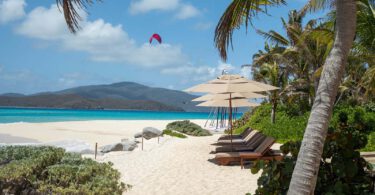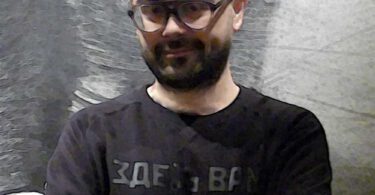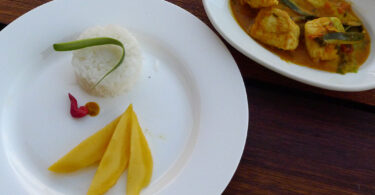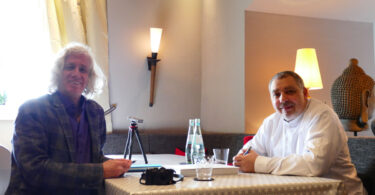bau.stil.
Development of a culinary signature
The culinary landscape in Germany has become incredibly exciting in the recent years. Creative minds such as Thomas Bühner, Kevin Fehling and Christian Bau, to cite just a few representatives of modern German premium cuisine, have contributed to this.
Christian Bau is one of the most interesting figures in the business, intellectual and impulsive, creative and determined, innovative and classic at the same time. In 2018, he is awarded “Chef of the Year” by Gault Millau, one of the highest awards in the cooking world!
In 2005 Bau is celebrating his third Michelin star, which marks one of the high points of his career.
It is an exciting time in the gastronomic scene, many top chefs pick up on the revolutionary inventions of the Spanish molecular genius Ferran Adrià, or follow the ideas of a sensual concept cuisine à la Heston Blumenthal. It is no longer just a matter of defending one’s stars with excellent craftsmanship, the best products and sophisticated technology, the culinary horizons are on the move, and classical French cuisine is no longer considered to be the measure of all things. Trends from Asia and Latin America are sloshing over the continents and bringing fresh ideas to the business.
Christian Bau recognizes the time signs and finds his unique culinary signature in a remarkable development.
Among other experiences, he learned at Harald Wohlfahrt, where he proves his talent, his cooking skills and his creativity. The way to the top of culinary art in Germany and on the international scene is programmed.
The gastro critic Wolfgang Ritter writes in 2008:
Christian Bau celebrates French haute cuisine without traditional opulence. His own, youthful style: classical but not old-fashioned, modern but not old-fashioned, modern but not too fashionable, delicate, with a subtle aroma, attractive appearance and harmonious elegance.
A good review, but in retrospect it turns out to be a snapshot, a interim balance. At this time, Christian Bau’s imaginations are still in the stage of pupation, shortly ahead of the metamorphosis.
2011 bau.stil. is published by the Edition Port Culinaire with Thomas Ruhl. The book is the key to the master chef’s ideas. Already in 2008, a publication by the publisher Umschau Verlag in Berlin entitled “Christian Bau, Einblicke” was released, but the work only focuses on the classical French phase.
Jürgen Dollase, who designed a FAZ Gourmetvision with Bau in 2009, writes the introduction, it follows a foreword by Harald Wohlfahrt, friend and mentor, early he discovers the special talent of the chef, in a way the two are like soul cousins.
The reader takes part in the process of self-discovery, learns what motivations and thought processes are important. Christian Bau is anchored in the classic French cuisine, giving priority to the taste effect and the highest possible precision in execution. Bau tells us that he doesn’t care for innovative excesses, from 2009 onward he reinvents himself, finally his thoughts culminate in the “Carte Blanche Menu”, which he implements in his restaurant in 2010.
For his personal development the encounter with Japanese culture is decisive, but the influences of the Far East are not merged thoughtlessly with a French classicism, Bau develops his own stylistic concept, integrating subtly the Japanese borrowings and creating something completely new.
bau.stil. is divided into six thematic complexes:
- Carte Blanche, exemption by free ticket
- Gourmet vision re-loaded. Japanese rethought
- Cosmopolitan. Innovation through integration
- Maximum precision. Genetically anchored
- Exceptional quality. Positively obsessed
- International network. Exchange and further development
The deciding moment to introduce the concept of the Carte Blanche at Berg Castle is a visit to Pascal Barbot at the “l’ Astrance” in Paris. Afterwards Bau is convinced that such a plan could also work for a European restaurant.
The principle of the carte blanche, however, is not simply introduced without words, but rather justified.
In star cuisine the quantity of the stored food exceeds every dimension, Carte Blanche optimises purchasing. A very good example are the fish dishes, which play an important role for Bau. Bau writes that with the introduction of the Carte Blanche, he has freed himself from the pressure to offer a wide range of products. Finally, the kitchen team also enjoys creative freedom, the experience factor is increased and the guest is emotionalized. Already at the premiere in 2010, the idea has been very well received.
Bau is still pursuing the concept of the Carte Blanche. The four-course surprise menu is practically a quintessence of the large degustation menus at Victor’s Fine Dining in Perl-Nennig (Paris-Tokyo, Prolog & Anschluss, Signatures).
A reference from this chapter is the
“Bresse dove by Claude Mièral, Boudin Noir & Sauerkraut, Nuts, Mole.”
The basic product, the dove, is served in variations. First covered with macadamia and parmesan crust (sous-vide) then as short roasted fillet and finally as pigeon’s leg praline made of macadamia, pigeon liver, -heart and foie gras. On top of it is the pigeon skin praline. This sensory masterpiece is created in combination with roasted black sausage. A puréed sauerkraut cream, short fried shallots, a cabbage sushi roll, granny smith pearls and some pigeon jus with mole.
The individual pigeon elements are finely worked out, a great dish!
Bau is highly sensitive to different flavours (oriental, Arabic, Mediterranean) and creates something completely individual.
Starting in 2009, the chef will take a deeper look at the Japanese cuisine tradition, but at the same time he will always remain authentic. He is not interested in a simple fusion cuisine, but rather in the analysis and reflection of Japanese taste-images.
It is a continuous process of culinary individualization and continuous development. Some Asian travels inspire the master chef, peu à peu he infects himself with the Japanese virus. He visits simple cookery, three-star sushi bars and traditional Kaiseki restaurants. Many conversations with Japanese colleagues allow him to experience the Japanese kitchen philosophy at close contact. Last but not least, he is impressed by the Japanese service mentality and the product and quality fanaticism. Of course, the FAZ Gourmetvision is also helpful at that time, when in addition to the normal menu, a Bau’ sches Japan menu is served.
in my opinion the reference plate:
“Seafood & Hamachi, Sepia raw marinated & sea cucumber. Sashimi of Hamachi. Seaweed. Marinade of oyster, lime, sake & rice vinegar ”
Dollase calls the dish a declination of seafood aromas, it is clearly avant-garde! First of all, the main character is not easy to identify, which proves the excellent balance of the plate. Without dominating, the oysters may gain ground in taste. Light spiciness (zucchini wasabi cream), melting and depth (sesame oil) and freshness (apple perfume). Wonderful!
Bau never forgot where he came from, he’s still close to his homeland. His roots lie in the heart of Baden, he was born and grew up in Offenburg. Harald Wohlfahrt gave him the finishing touches, here he learned the wonderfully light French cuisine.
The dishes of Christian Bau are not explicitly Japanese or French, the elements he used express his feelings. Again and again Bau understands how to break up structures, also of a kitchen-technical nature, a relaxed menu sequence, the many amuse-gueules and the entremets, Bau is open for everything, one could speak of a “Voyage Culinaire”. Bau is a cosmopolitan, always receptive to new impressions, he is not bound to certain ideas, but always pursues his own style, which is vividly reflected in his dreamlike recipe design.
“Pear tart Mal Anders”
This deconstruction of a classic French pear tart is modern and timeless.
Crispy crumbles form the base. The pear is intensified with pear jelly. Salt-butter caramel cubes, small crème brulée elements and a pear candy complete the creation. The sensory fireworks are provided by the brioche ice cream. Great!
The career of Christian Bau is characterised by solid craftsmanship and the highest possible precision, he was only with the very best teachers, after all Sous chef at Harald Wohlfahrt in the famous Schwarzwaldstube in Tonbach. Until today, no plate leaves the pass-through without the chef’s approval. The food is checked every morning and the most important sauces are prepared by the chef.
His approach is fairly intuitive, Christian Bau:
Most of the dishes come from a reflection that aims at a taste effect, then some samples are cooked and the dish is successively optimized before the guest is presented with it, I do what I feel!
“Langoustine’s medallions. Yogurt. Pumpkin. curry oil ”
A two-part Langoustine dish. Bau presents several sequential preparations of the theme. The piece, however, is not a technical etude but rather a kind of chamber music overture, a melody that is later taken up by the main dish.
The structure is reminiscent of the patisserie, foam and ice are used. Pumpkin ice cream and foam are discreetly seasoned, so that the Langoustine, which is gently dragged through lime marinade, can shine in the composition. Iodine aromas, fresh, slightly pungent, crisp and deep. Excellent!
“Quality comes from torturing oneself”, is probably written above the pass at Schloss Berg. Already Alain Ducasse coined a culinary formula for haute cuisine:”Cooking is 60% the product and 40% the technique”.
Bau has taken this into his heart, for his guests there are only the very best products in the best possible preparation. In this context, there will be no regional cuisine at Schloss Berg, the idea is not compatible with the cosmopolitan philosophy. Christian Bau makes this clear:
Certainly nowadays there are many local German producers who can supply excellent products, but for a long-term menu strategy there is no constant high quality and necessary quantity. However, the Carte Blanche gives me additional scope to consciously use the quality peaks of regional producers.
Bau is obsessed with the idea of quality, and there are plenty of examples of this: Koshihihikari rice, or the priceless Matsubadaki algae.
Contact with Japanese cuisine has, of course, further increased the quality standard.
“Frog legs.
Sauté. Bouillon with dumpling. Watercress & Enoki ”
Very good West-East integration. Asian note due to Wan-Tan pastry and enoki mushrooms. Integration of two panoramas, on the one hand classic interpretation of baked frog’s legs with watercress and spinach, on the other hand Wan-Tan inspired soup based on a frog’s leg broth. Exciting dramaturgy!
Christian Bau recognised early on the significance of an international network. With the “Madrid Fusion”, the Spanish have created a groundbreaking format, where chefs themselves discuss the latest developments and expose themselves to unvarnished criticism from colleagues.
Bau knows that German chefs don’t have to be afraid of international comparisons, the perception on the world stage is rising, but there is still a lot to be done.
But not only the presence at culinary festivals is important, also Bau has invited the Japanese chef Taku to take part in an important phase, when he wanted to integrate the Far Eastern ideas even better into his own developments. One topic is the economy in top gastronomy, for example, the booking situation, the use of goods and the menu prices. Bau is constantly pushing its internationalisation.
“Oyster. Oyster. Oyster ”
A masterpiece. An extraordinary oyster variation.
Poached oysters, oyster chips, oyster spuma, oyster water with green and white tapioca and shock frozen silver plated oyster pearls.
Different techniques, temperatures. This results in unexpected textures.
Fresh, clear and pure. Micromoments of almost contemplative nature. Sweet acid game.
Fantastic!
bau.stil. is a book that is recommendable in every aspect. The fantastic photos of the editor Thomas Ruhl bring the idea and execution of Bau’s kitchen perfectly into the limelight. Jürgen Dollase is absolutely right when he talks about a future German university of cooking, this work belongs in a virtual course, fundamental, inspiring! Unfortunately there is no new edition, for the antiquarian bookshop a very clear recommendation, a classical!
![[:de]Grandgourmand, Travel, Food, Lifestyle[:]](https://grandgourmand.de/wp-content/uploads/2023/01/logo_23_1-1.png)




